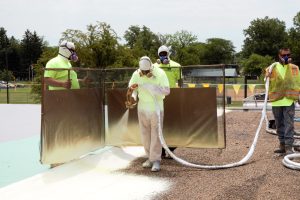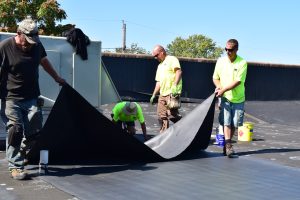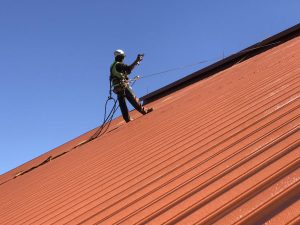When we meet with future clients, they are usually comparing several types of roofing systems. We are always asked: Which is better? Which is more reasonably priced? What is the commercial roof installation process?
At West Roofing Systems, we want to make sure that our future clients have the best information available. For this reason, we created an article that explores the differences between Spray Polyurethane Foam, Single-Ply Membrane and Metal Roofing systems to give you all the information you need in choosing which roof for your commercial facility.
Commercial Roof Installation: The Basics
Spray Polyurethane Foam (SPF) Roofing
Spray Polyurethane Foam, more commonly referred to as SPF, is a material that is sprayed and expands into a foam, creating a solid layer across an existing roof.
While SPF roofing is not the most known type of roofing material, the technology has been around since the early 1960s for industrial, commercial, and residential facilities.
Read More: Spray Polyurethane Foam (SPF) Roofing: Installation & Performance
Single-Ply Membrane Roofing
Single-Ply Membranes are sheets of rubber and other synthetics that can be chemically adhered to insulation or ballasted creating a layer of protection on your commercial facility.
There are two main types of single-ply membrane commercial roofing: Thermoplastic Polyolefin (TPO) and Ethylene Propylene Diene Terpolymer (EPDM). They differ in their chemical makeup, how they are installed and the energy efficiency.
Read More: Single-Ply Membrane Roofing: Installation & Performance
Metal Roofing
Metal Roofing is one of the oldest commercial roofing systems on the market.
Most metal roofing systems use corrugated galvanized steel, although other materials such as aluminum or tin can also be used. After a metal roofing system is installed, a coating can be added for waterproofing, rust protection, and UV protection.
Commercial Roof Installation: The Process
Spray Polyurethane Foam (SPF) Roofing
Before the installation can start, the existing roof needs to be prepared. Rather than stripping the existing roof, the contractor will most likely prepare the substrate by getting rid of all dirt, dust, and contaminants.
The first layer put down by the contractor is the polyurethane foam. This foam is created by combining two liquids as it’s sprayed onto the existing roof substrate. As the liquid is sprayed onto the existing roof, it expands to form a solid foam surface.
When the SPF layer has been completed, it is then coated with a layer(s) of elastomeric silicone or acrylic coating with embedded granules.
Download: The Essential Guide to Spray Polyurethane Foam Roofing
Single-Ply Membrane Roofing
The beginning of the installation process is similar between TPO and EPDM single-ply membrane roofing systems.
 After the existing substrate is prepared, either by cleaning or removing the existing roof, the insulation is installed. There are a few types of insulation options the facility manager/owner can choose from Polyisocyanurate (Polyiso), Expanded Polystyrene (EPS), Extruded Polystyrene (XPS)
After the existing substrate is prepared, either by cleaning or removing the existing roof, the insulation is installed. There are a few types of insulation options the facility manager/owner can choose from Polyisocyanurate (Polyiso), Expanded Polystyrene (EPS), Extruded Polystyrene (XPS)
After the existing substrate is prepared, either by cleaning or removing the existing roof, the insulation layers are installed and covered by a cover board.
There are three ways to attach the membrane to the cover board: ballasted, with an adhesive or mechanically fastened.
The significant difference between TPO and EPDM comes when it is time to adhere the membrane seams together. TPO uses a hot-air gun to melt down the membrane at the seams and fuse them together. EPDM is joined together with a seam tape.
Download: The Essential Guide to Single-Ply Membrane Roofing
Metal Roofing
Since metal roofing material is rather light in weight, it can be installed right on top of the existing roof. A contractor will install a frame, or substrate, with trusses and purlins for the metal roof to be fastened to.
After the existing roof is prepared, your contractor will install a layer of insulation. There are a few types of insulation options available:
- Roofing Felt
- Fiberglass
- Rigid Board
- Bubble Insulation
- Spray Foam
After the insulation is installed, metal panels are cut and attached to the frame with screws. These panels are installed with overlapping edges to cover all the exposed insulation underneath. Flashings are mounted on the joints of the roof.
Commercial Roof Installation: The Cost
Spray Polyurethane Foam (SPF) Roofing
For an average 20,000 sq. foot commercial roof, it will usually cost between $4.00 and $7.00 per square foot in materials and labor to install a typical SPF roofing system. This price range is for an SPF roof of average thickness and building structure.
Read More: Cost of a Spray Polyurethane Foam Roofing System
Single-Ply Membrane Roofing
For an average 20,000 sq. foot commercial roof, it will usually cost between $3.50 to $7.50 per square foot for EPDM and $3.50 to $6.50 per square foot for TPO, including materials and labor warranty.
Read More: Cost of Single-Ply Membrane Roofing
Metal Roofing
For an average commercial roof installation, it will usually cost between $5.00 and $10.00 per square foot in materials and labor to install a typical metal roofing system. This price range can change depending on the type and style of the metal panels you choose.
Read More: Average Cost of Metal Roofing per Square Foot
As you can see, SPF, single-ply membrane and metal roofing are all popular and comparable for commercial roofing. They each have their advantages along with disadvantages, depending on your facility, location and climate you and your roofing expert can choose the right roof system.
West Roofing Systems, Inc. installs sustainable and efficient roofing systems for commercial, industrial, manufacturing and municipal buildings. In over 37 years, we have installed over 56,000,000 square feet of commercial Spray polyurethane foam (SPF), single ply membrane and other popular roofing systems.
If you are looking for maintenance, repair or a commercial roof installation for your facility’s roof, fill out our quote form for your free no-obligation commercial roof quote from our team of experts.


